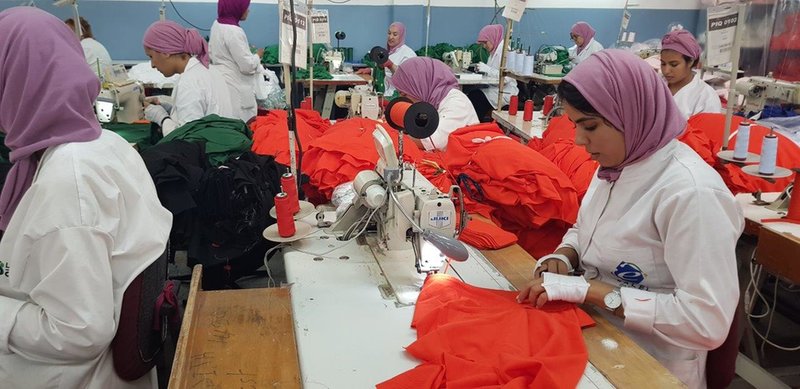With a mere 14km separating Morocco's key Tanger-Med port and Spain across the Strait of Gibraltar, the north African country should be a natural leader in short orders and fast fashion for European markets.
However, one of the biggest challenges are the duty-free rules of origin that Morocco must negotiate to access its key markets in France and Spain under the 20-year-old EU-Morocco Association Agreement.
According to Eurostat Comext data, Morocco's clothing and textile exports to the EU were valued at EUR2.99bn (US$3.2bn) in 2018 – representing 18.5% of the European bloc's total imports from the country. Within this, clothing accounted for EUR2.75bn (a rise of 3% year-on-year) and textiles EUR239m.
But Mathias Knappe, programme manager for fibres, textiles and clothing at the Geneva-based International Trade Centre's (ITC) division of enterprises and institutions, says Morocco struggles to fulfil the double transformation rule of origin insisted upon within the agreement.
“Without having a sophisticated textile industry, companies need to use EU-originating fabrics or those from Egypt or Turkey to get duty-free entry.” – Mathias Knappe, International Trade Centre's (ITC)
"Without having a sophisticated textile industry, companies need to use EU-originating fabrics or those from Egypt or Turkey to get duty-free entry." If they use Asian fabrics, they pay a levy of 12%, he notes.
As a result, there is a lot of attention within the Moroccan clothing sector about ongoing negotiations with the EU to forge a new Deep and Comprehensive Free Trade Area (DCFTA) between the two.
Fatima-Zhora Alaoui, the director general of Morocco's clothing and textile industry association AMITH (Association Marocaine des Industries du Textile et de l'Habillement), says it is collaborating closely with the neighbouring Tunisian clothing industry during the trade talks.
"We decided with the FTTH [the Tunisian Federation of the Textile and Garment Industry – Fédération Tunisienne du Textile et de l'Habillement] to go together to negotiate as a front, instead of individually."

Strategic importance
The textile and clothing industry is a strategically important sector for the Moroccan economy. According to the Moroccan ministry of industry, commerce and the digital economy, it accounts for 7% of all industrial added value and 5% of all industrial production.
The sector includes 1,200 companies employing 165,000 people, or 27% of all industrial employment. Aside from fast fashion, Moroccan production includes knitwear, denim and textiles for the Moroccan automotive and aeronautical industries.
Until recently Moroccan factories have relied on CMT (cut, make and trim), being able to respond to European short-ordering. But to keep pace with its competitors, "we now do full collections, which makes us more attractive to brands and retailers to better manage their stocks," Alaoui says.
Morocco's government has supported the industry to become more competitive, with an Industrial Acceleration Plan 2014-2020 coming to an end this year. A broader economic growth plan looking forward to 2025 – dubbed 'Maroc 2025' – is due to start in 2021, and is targeting market growth, production, quality, employment and export sales in the textile and clothing sector.
Capacity-building programme
In addition, the International Trade Centre's GTEX/MENTATEX division (Global Textiles/Middle East and North Africa Textiles) is running a bespoke capacity-building programme for 36 selected Moroccan companies, who focus on fast fashion, knitwear and denim.
To empower local agencies to continue this development process, GTEX/MENTATEX specialists are training Moroccan institutions including AMITH, the textile technology school ESITH (Ecole supérieure des industries du textile et de l'habillement), the design school Casa Moda, in Casablanca, and textile technical and testing centre CTTH (Centre Technique Textile Habillement).
Zhor Ababou, national coordinator for the GTEX/MENATEX project in Morocco, says it is helping companies develop beyond CMT to offer a full package service to customers. She says to a large extent, in Morocco "upstream doesn't exist so it is important to emphasise the sourcing of primary materials."
The programme will also support access to finance so that companies can gain the investments needed to grow their businesses and upgrade technology.
Knappe says its final phase is "diversification into new markets, places where they [Moroccan clothing exporters] have not looked into so deeply," such as the UK, Nordic countries and Germany, expanding sales in partnership with Morocco's investment and export agency AMDIE (Marocaine de Développement des Investissement et de l'Export) and AMITH.
Headline image: Jamaa el Fna market in old Medina, Marrakesh, Morocco
BACK TO TOP